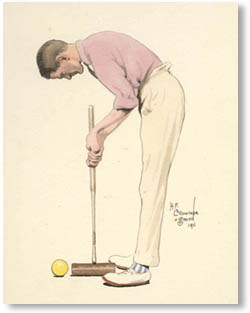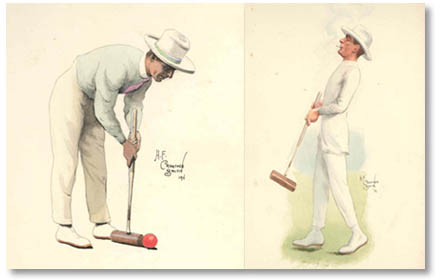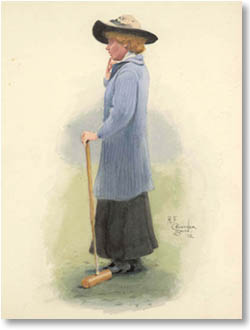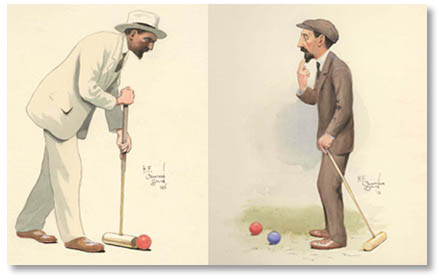

|
Back to |
| The Front Page |
| News & Features |

| From the bibliographer's casebook: A ripping yarn with a happy ending | ||||||||||||||
|
by David Drazin portraits by Horace Francis Crowther-Smith Posted September 17, 2008
|
||||||||||||||
|
||||||||||||||
Though it is certainly remarkable that I was in the thick of it from start to finish, the odds against my involvement at every stage of this little drama were probably a lot less that might be imagined, because I am a dedicated collector of croquet memorabilia and was privileged to count the late Alan Oldham, past Croquet Association Treasurer, Vice-President, and Archivist, as a close friend. So when, out of the blue in April or May 2004, Alan received as donations to the Association two precious books of artwork by Horace Francis Crowther-Smith ('Crowther'), master croquet caricaturist, it was natural that Alan should show them to me.
Knowing that the Association had limited curatorial resources, it was only natural that I should take the trouble to scan both books from cover to cover for the benefit of anyone who might care to examine them. It was natural too that I should inform the police of their theft from Alan's car when we were in Brighton together for the WCF World Golf Croquet Championship in June 2004; and, having long since given up hope of ever seeing them again, it was natural, as a daily visitor to the eBay website, that I should see them offered for sale by a Hampshire dealer on 28 May 2006, the day after the auction was posted.

|
| Cyril Corbally, 1911 and 1912. This brilliant Irish player was five-times Open Champion and winner fo the 1913 Champion Cup, forerunner of the President's Cup. |
Swinging into action, I telephoned the Sussex Police, quoting the Crime Number they had given me two years earlier when I had reported the theft, and suggested that they ask eBay to pull both auctions. The goods on offer had clearly been stolen and it would obviously have been unhelpful to allow the auctions to proceed. But, notwithstanding their professed commitment to co-operate with authorised law enforcement agencies, we never supposed that eBay were so responsive that their co-operation could be taken for granted. So, while the police inspector in charge of the case was doing battle with their administration, the croquet world closed ranks and mounted a spirited defence.

|
| C.L. O'Callaghan, 1911 and 1912. Another brilliant Irishman was three-times Open Champion and three-times winner of the Champion Cup. |
Just in case the auctions should run to full term despite police intervention, Tremaine Arkley of Oregon, a good friend and benefactor of the Croquet Association and a leading collector worldwide of croquet art, generously agreed to put in safety bids, undertaking to pay up to £2888.88 for each volume in case of need and, if called on to purchase both volumes, to donate them (for a second time) to the Croquet Association.

|
| Mrs R.C.J. Beaton (née Lily Gower), 1912. This famous 'Lady Champion of England' was 1905 Open Champion and 1904 winner of the Champion Cup. This may be the only extant image of the celebrated croquet pin-up in full colour. |
By a sad and strange turn of fate, Alan Oldham had died on 28 April 2006, a month before this little story began. He had been badly shaken by the loss of priceless Association property in his charge and, having then assumed that the books would never be seen again, he would have been thrilled to learn there was now every prospect of recovering them. And so in fact was his family who survived him, who were kept informed of the elaborate plans being laid for the "sting."
The auctions were due to end at 6 pm on 7 June, the day before Alan's memorial service was to take place in the church of St Francis of Assisi, Terriers, near his home outside High Wycombe, Bucks; and, as eBay had taken no action to terminate the auctions, the few of us who knew what was going on were on the edge of our seats. How would the story end? What would we tell the Oldham family and the croquet establishment at Terriers Church? Would the Sussex Police stop the auction, or would the sales run their course?
And if the auctions ran their course, would Tremaine prevail, how much would he have to pay, and would the police then step in to reclaim property they had reason to believe was stolen? At the bottom line, who would pay how much at the end of the day?
As the hours passed by, the picture took shape. The auctions duly ended, Tremaine winning one volume for £460 and the other for £360. Though the croquet world held back, there was never any way I could induce outsiders to do so. Fully in the spirit of the sting, to assist the police in identifying and locating the vendor, Tremaine offered to pay him by means of an instrument addressed to his home. Tremaine emailed this address to me, I relayed it to the Sussex Police, they promised to swoop, and swoop they did! Two lovely books were once again safe in the hands of the Croquet Association.

|
| R.G.J. Beaton, 1911 and 1912. This proprietor of a famous goatee was Open Champion in 1904 and 1907 and won the Champion Cup in 1905. |
Having been primed by the police, at Alan's memorial service I was able to tell the family, the Association secretary, and a few other croquet notables that we had good news. The Sussex Police had reclaimed the two stolen books at about 2.00 pm, the very time that we were being welcomed to Terriers Church by the minister who officiated at the service. A few of us had no doubt that this coincidence was set up by Alan from the other side!
Inspector McCarthy of the Sussex Police told me that the vendor looked as clean as a whistle. He was a dealer of good standing who claimed to have bought the books in all innocence for £5 each at a car boot sale. He was pleased to co-operate with the police as best he could, he declined Tremaine's offer of payment, and expressed deep regrets for having been innocently involved in trading stolen property. Mr McCarthy suggested it would be a fitting gesture to refund his £10 outlay, and this I did.

|
| P. Duff Mathews, 1911 and 1912. He won the 1912 Champion Cup and was the eponymous inventor of the "duffer tice." |
Alan Oldham had been the Croquet Association treasurer for all of 25 years. If he had been in post to draw a line under this story and record the total net liability, we might suppose that he would have been well satisfied. The ending of this story might have been even happier if effective action had been taken against eBay for failure to co-operate with an authorised law enforcement agency. But, as Mr McCarthy mused, life is too short. eBay are smart and police resources were already over-stretched.

|
| Edgar Whitaker, 1911. This founding father of the New Zealand Croquet Association and author of "Modern Croquet" was also a notorious double-tapper who nevertheless won the 1911 Open Championship, the Beddow Cup in 1926 and the Champion Cup in 1927. |
So the brief forewords I appended to the facsimiles I deposited with the Association office in 2004 noted that their origins were obscure. But now we have a good clue at least. On learning that the books had shown up on eBay, Roger Wood of Compton told me the circumstances in which Margaret Payton first brought the Chittenden gift to the notice of the club. In the early years of the last century Barbara Chittenden was very close to Nora, widow of the Rev George Frederick Handel Elvey, a past Croquet Association chairman. She may well have received Crowther's work from the Elveys. But how they got into the Rev Elvey's hands in the first place remains a mystery.
POSTSCRIPT: As this story shows, bibliographers and collectors often play
heroic roles in discovering the provenance of works of art, recovering stolen
works, and even bringing art thieves to justice. If you have information
bearing on the subject of this article, contact the editor of Croquet World or Dr.
David Drazin at d.drazin@ntlworld.com.